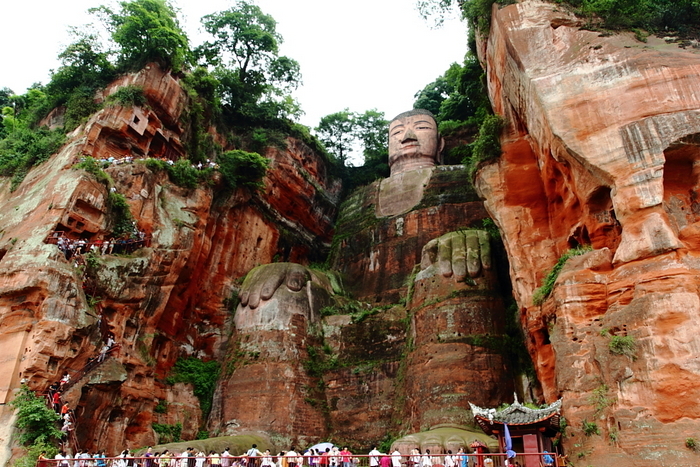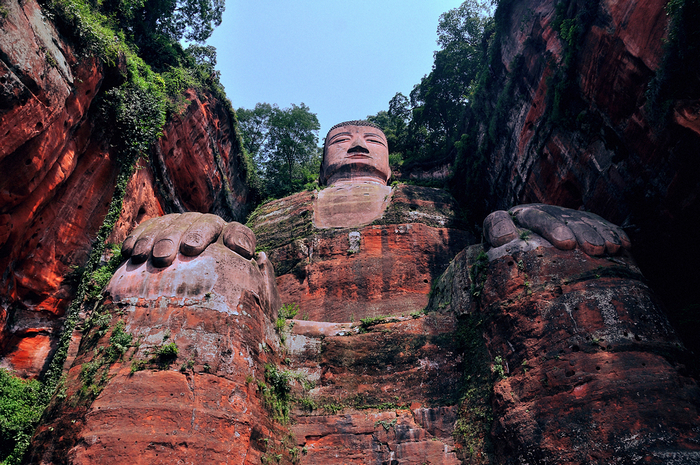

Introducing Leshan Giant Buddha (from wikipedia)
The Leshan Giant Buddha is a 71-metre (233 feet) tall stone statue, built between 713 and 803 during the Tang dynasty, depicting Maitreya. The Leshan Giant Buddha is carved out of a cliff face of Cretaceous red bed sandstones that lies at the confluence of the Min River and Dadu River near the city of Leshan. The Leshan Giant Buddha faces Mount Emei, with the rivers flowing below its feet. The Leshan Giant Buddha is the largest and tallest stone Buddha statue in the world and it is by far the tallest pre-modern statue in the world. The Mount Emei Scenic Area, including Leshan Giant Buddha Scenic Area, has been listed as a UNESCO World Heritage Site since 1996.
Leshan Giant Buddha Fast Facts
• Chinese Name: Le Shan Da Fo 乐山大佛
• Best Time to Visit: April, May, Jun, Sept & October
• Recommended Visiting Hours: About 2 to 3 hours
• Type: Buddhism
• Opening Hours: 07:30-18:30 from Apr 1 to Oct 7; 08:00-17:30 from Oct 8 to Mar 31
• Entrance Fee: CNY 80 (Excluding cruise ticket CNY70)
• Address: No. 2435 Lingyun Road, Leshan, Sichuan Province
What UNESCO says of Leshan Giant Buddha
Carved in the 8th century CE on the hillside of Xijuo Peak overlooking the confluence of the Minjiang, Dadu and Qingyi rivers, the 71 meter tall Giant Buddha of Leshan is the largest Buddhist sculpture in the world. A contemporary account of the creation of the Giant Buddha is preserved in the form of an inscribed tablet. Associated monuments include the 9th century Lingbao Pagoda and the Dafo (Giant Buddha) Temple dating from the early Qing Dynasty. The Wuyu Temple contains two important statues: the 9th century Dashi bronze Buddha and the 11th century Amithabha statue group, cast in iron and gilded.
What to expect at Leshan Giant Buddha
Leshan Giant Buddha Scenic Area is about 150km away from Chengdu. Minjiang River, Qingyi River and Dadu River converge in this area. The Scenic Area is surrounded by mountains and rivers with exquisite scenery and integrated with the cultural and natural landscapes.
Leshan Giant Buddha
In ancient times, people worshiped Mt. Emei and Leshan Giant Buddha; the world famed Leshan Giant Buddha, a Maitreya status, is located on the palisades at the confluence of the Minjiang River, Dadu River and Qingyi River. The construction of Leshan Giant Buddha was commenced in the early years of Kaiyuan Period in the Reign of Emperor Xuanzong in the Tang Dynasty (713AD) and completed in the 19th year of Zhenyuan ofthe Reign of Emperor Dezonginthe Tang Dynasty (803AD)for 90 years; a monk named Haitong initiated and called up manpower to build the Grand Buddha for water potential reduction and universal salvation.
Grand Sleeping Buddha
"Grand Sleeping Buddha", also called "Hidden Sleeping Buddha", is located at the confluence of three rivers, namely the Minjiang River, Dadu River and Qingyi River near Leshan City; the vivid head, body and feet of Buddha are formed by Wuyou Mountain, Lingyun Mountain and Dongyan, and it lies on the bank of three rivers with head in the south and foot in the north with north-south linear distance about 1,300m. The "Head of Buddha" of "Grand Sleeping Buddha" is vivid and formed by Wuyou Mountain with Jingyun Pavilion as its "Eyelash", crowns on the peak as "Forehead, Nose, Lip and Jaw", Qiluan Peak and Jifeng Peak of Lingyun Mountain as "Chest of Buddha", Lingbao Peak as "Abdomen and Thighs", Jiuri Peak as "Shanks" and south slope of Dongyan as "Legs".
Oriental Buddha Park
Oriental Buddha Park, a large treasure of Buddhist arts was completed and opened in Leshan, China in May 1994. It is only 1km away from the world famed Leshan Giant Buddha, an extension of Buddhist culture of Leshan Giant Buddha Scenic Area, and a main part of Leshan Giant Buddha Tourist Attraction; within an area of 200,000sq.m, it has over 3,000 imitative domestic and foreign Buddha statues, forming a magnificent Buddhist scroll corridor by the natural extended and sinuous mountains, and fully presenting the style of Buddhist arts in China and Southeast Asia by sculptures in round, reliefs, carvings and murals made from different materials of stone, copper, painted sculptures and black jade etc.
How to get to Leshan Giant Buddh
• Leshan Giant Buddha is located 150km away from Chengdu.
• Take a tourist bus from Chengdu New South Gate to Leshan Xiaoba Bus Station or Leshan Scenic area.
• Rent a car/bus from GGC to enjoy a hassle free private transfer from hotels in Chengdu to Leshan Giant Buddha.
Additional travel advice on Leshan Giant Buddha
• Children, seniors and people with poor healthy conditions are not recommended to make the climb.
• It often rains on the mountain. Please prepare an umbrella or a raincoat along with you.
• Long-sleeved clothes are necessary to prevent mosquito bites or prepare mosquito repellent.
• Please take care when taking a cruise.